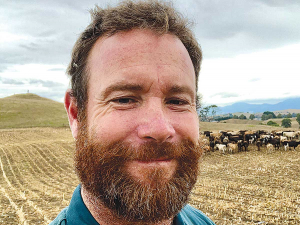Boost for NZ, Nordic Jerseys genetic link
A new collaboration is underway to improve the genetic links between the New Zealand and Nordic Jersey cattle populations.
 Ben Watson, dairy farmer and Jersey Advantage committee chair, farms 1,700 Jersey and Jersey X cows across three dairy farms in Walton and Piopio.
Ben Watson, dairy farmer and Jersey Advantage committee chair, farms 1,700 Jersey and Jersey X cows across three dairy farms in Walton and Piopio.
A farmer group promoting Jersey cows says stock and semen sales indicate the breed is on the rise.
Jersey Advantage chairman Ben Watson says the economic benefits of the Jersey breed are undeniable.
“We’re seeing the market respond to that.”
The group says it’s a sentiment that Ross Riddell, general manager of Link Livestock agrees with.
“Demand for Jersey herds and stock lines have been significantly ahead this season, and we’re getting good interest in surplus in-calf Jersey stock,” says Riddell.
“Prices for in-milk stock are at least as high as the other breeds but in many cases higher due to shortage in supply.
“The drought conditions in many areas may exacerbate the problem and push prices higher with farmers not in a feed position to carry surplus in-calf cows through to the end of the season for other farmers to purchase.”
LIC, who supply semen to around 80% of the industry, also experienced an increase in Jersey semen sales this season.
Jersey sales of LIC’s flagship AB product – Premier Sires – ended the season 2% ahead of last year at 14% while their frozen product was also up 2% to 21% of total frozen straws.
With increased demand for Jersey semen LIC have decided to extend their fresh sexed semen offering next season to include Jersey.
All this is good news for those wanting to get more Jersey genetics in their herd, says Watson.
“There’s long been acknowledgment of the ability for Jersey’s to convert feed into milksolids more efficiently than any other breed, and we’re seeing renewed interest in Jersey’s due to strong milkfat prices. All indications are that a VCR of parity to 1.2 is the new normal.”
“Increasingly farmers are also becoming aware of the breed difference in pregnancy rates. This spring the majority of Jersey herds are reporting non-pregnancy rates in the 7-12% range, whereas the typical Holstein Friesian herd is around 11-17%. This variation makes a significant difference to year-on-year replacement rates, farm carbon emissions and the cost of rearing young stock,” says Watson.
The Jersey breed also has the advantage when it comes to those wanting A2 animals. “Around 60% of the Jersey population carry the A2A2 gene, compared to 44% for Holstein Friesian and 53% for crossbreeds,” says Watson.
“It’s certainly something farmers should be thinking about when they make their breeding decisions next season.”
The National Wild Goat Hunting Competition has removed 33,418 wild goats over the past three years.
New Zealand needs a new healthcare model to address rising rates of obesity in rural communities, with the current system leaving many patients unable to access effective treatment or long-term support, warn GPs.
Southland farmers are being urged to put safety first, following a spike in tip offs about risky handling of wind-damaged trees
Third-generation Ashburton dairy farmers TJ and Mark Stewart are no strangers to adapting and evolving.
When American retail giant Cosco came to audit Open Country Dairy’s new butter plant at the Waharoa site and give the green light to supply their American stores, they allowed themselves a week for the exercise.
Fonterra chair Peter McBride says the divestment of Mainland Group is their last significant asset sale and signals the end of structural changes.
President Donald Trump’s decision to impose tariffs on imports into the US is doing good things for global trade, according…
Seen a giant cheese roll rolling along Southland’s roads?